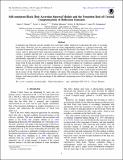| dc.contributor.author | García, Javier A. | |
| dc.contributor.author | Eikmann, Wiebke | |
| dc.contributor.author | McClintock, Jeffrey E. | |
| dc.contributor.author | Brenneman, Laura W. | |
| dc.contributor.author | Dauser, Thomas | |
| dc.contributor.author | Fabian, Andrew C. | |
| dc.contributor.author | Steiner, James F | |
| dc.date.accessioned | 2017-06-08T14:03:47Z | |
| dc.date.available | 2017-06-08T14:03:47Z | |
| dc.date.issued | 2017-02 | |
| dc.date.submitted | 2017-01 | |
| dc.identifier.issn | 1538-4357 | |
| dc.identifier.issn | 0004-637X | |
| dc.identifier.uri | http://hdl.handle.net/1721.1/109734 | |
| dc.description.abstract | Continuum and reflection spectral models have each been widely employed in measuring the spins of accreting black holes. However, the two approaches have not been implemented together in a photon-conserving, self-consistent framework. We develop such a framework using the black hole X-ray binary GX 339–4 as a touchstone source, and we demonstrate three important ramifications. (1) Compton scattering of reflection emission in the corona is routinely ignored, but is an essential consideration given that reflection is linked to the regimes with strongest Comptonization. Properly accounting for this causes the inferred reflection fraction to increase substantially, especially for the hard state. Another important impact of the Comptonization of reflection emission by the corona is the downscattered tail. Downscattering has the potential to mimic the relativistically broadened red wing of the Fe line associated with a spinning black hole. (2) Recent evidence for a reflection component with a harder spectral index than the power-law continuum is naturally explained as Compton-scattered reflection emission. (3) Photon conservation provides an important constraint on the hard state's accretion rate. For bright hard states, we show that disk truncation to large scales R ≫ R[subscript ISCO] is unlikely as this would require accretion rates far in excess of the observed [dotM] of the brightest soft states. Our principal conclusion is that when modeling relativistically broadened reflection, spectral models should allow for coronal Compton scattering of the reflection features, and when possible, take advantage of the additional constraining power from linking to the thermal disk component. | en_US |
| dc.description.sponsorship | United States. National Aeronautics and Space Administration (PF5-160144) | en_US |
| dc.language.iso | en_US | |
| dc.publisher | IOP Publishing | en_US |
| dc.relation.isversionof | http://dx.doi.org/10.3847/1538-4357/836/1/119 | en_US |
| dc.rights | Article is made available in accordance with the publisher's policy and may be subject to US copyright law. Please refer to the publisher's site for terms of use. | en_US |
| dc.source | IOP Publishing | en_US |
| dc.title | Self-consistent Black Hole Accretion Spectral Models and the Forgotten Role of Coronal Comptonization of Reflection Emission | en_US |
| dc.type | Article | en_US |
| dc.identifier.citation | Steiner, James F.; García, Javier A.; Eikmann, Wiebke; McClintock, Jeffrey E.; Brenneman, Laura W.; Dauser, Thomas and Fabian, Andrew C. “Self-Consistent Black Hole Accretion Spectral Models and the Forgotten Role of Coronal Comptonization of Reflection Emission.” The Astrophysical Journal 836, no. 1 (February 2017): 119 © 2017 The American Astronomical Society. | en_US |
| dc.contributor.department | MIT Kavli Institute for Astrophysics and Space Research | en_US |
| dc.contributor.mitauthor | Steiner, James F | |
| dc.relation.journal | Astrophysical Journal | en_US |
| dc.eprint.version | Final published version | en_US |
| dc.type.uri | http://purl.org/eprint/type/JournalArticle | en_US |
| eprint.status | http://purl.org/eprint/status/PeerReviewed | en_US |
| dspace.orderedauthors | Steiner, James F.; García, Javier A.; Eikmann, Wiebke; McClintock, Jeffrey E.; Brenneman, Laura W.; Dauser, Thomas; Fabian, Andrew C. | en_US |
| dspace.embargo.terms | N | en_US |
| mit.license | PUBLISHER_POLICY | en_US |
